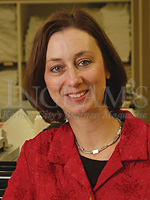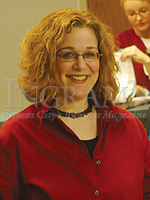K.J. Langlais & Penny Shaffer GERTI

When K.J. Langlais and Penny Shaffer met several years ago at an aging conference, they recognized a shared concern for the practice and education of long-term care for the elderly. A year later, they opened the Geriatric Education, Research & Training Institute, (GERTI). Since October 2003, more than 300 students have gone through the program, and Langlais and Shaffer have recently expanded classes to Manhattan, Hays and other parts of Kansas.
Housed in the Johnson County Nursing Center (JCNC), GERTI was established to improve skill levels and better educate nurses, nursing home administrators and others about long-term care and healthcare services for elders with dementia. In her 23 years as a nursing home administrator and consultant, JCNC and GERTI Executive Director and Administrator Langlais detected “not only a hunger for communication and education, but a system struggling. My passion is trying to right a wrong in the healthcare industry.”
With more than 20 years' experience as a nurse and instructor of geriatric psychiatry, Shaffer came to the same conclusions. As GERTI's director of education, she assesses each new group of students and teaches 90 percent of the courses. The 40-hour comprehensive education program teaches, among other things, Resident Assessment & Care and Understanding Dementia, Depression & Delirium.
Debbi Riess-Roam St. Mary's Hospital of Blue Springs

Debbi Riess-Roam traces her career in physical therapy to a movie, a specific scene in fact.
The movie, “The Other Side of the Mountain,” is based on the true story of Jill Kinmont, a gifted skier destined for the Olympics until a skiing accident paralyzes her from the shoulders down. The intense scene that so inspired Riess-Roam involved Kinmont's physical therapy as she attempts to return to a fulfilling life.
“I saw that and thought, 'That’s what I want to do,” says Riess-Roam. “That night I went home and told my mom, 'I want to be a physical therapist!'”
As director of the Regional Rehabilitation Center at St. Mary’s Hospital of Blue Springs, where she’s worked since 1985, Riess-Roam still finds her job as satisfying as she hoped it would be after seeing it on the big screen.
“Physical therapy encourages the redevelopmentof a person,” said Riess-Roam. “We use whatever wehave available to us to make a person feel whole after an injury.”
In addition to working with patients, Riess-Roam also oversees the center’s staff development, marketing and compliance. But most of all it's the center’s attention to customer service that Riess-Roam finds truly satisfying.
All of healthcare is starting to “look at it from the customer’s perspective,” says Riess-Roam. “That excites me—making our patients and their families feel valued, feel that we want to take excellent care of them. It's an exciting time to work in healthcare.”
Julie Hirsch-Bohs North Kansas City Hospital

Quite often, Julie Hirsch-Bohs and her staff are a doctor’s last resort. “I always say that when they don’t know who to turn to, doctors write a work order for us.”
Hirsch-Bohs supervises the social work staff at North Kansas City Hospital. As patient advocates, Hirsch-Bohs and her staff shoulder a wide-range of responsibilities—ensuring patients have necessary medical equipment such as oxygen and walkers, making home healthcare arrangements, finding a place for the homeless and domestic abuse victims, securing addiction rehabilitation services or psychiatric care, facilitating hospital-to-hospital transfers or even helping patients navigate the paper trail of insurance forms.
In short, Hirsch-Bohs says, she and her staff within the hospital are responsible for helping patients deal with everything from the outside world. It’s just the type ofwork Hirsch-Bohs hoped for three years ago when, aftera decade and a half of social work, she sought to apply her skills in a hospital setting.
Working in a hospital, “you have more of an impact,” says Hirsch-Bohs. “You're helping more people with a more positive outcome in a shorter amount of time.”
Hirsch-Bohs says she also enjoys the fruits of teamwork that come with working in a clinical setting. “You see people come in here in such critical condition that you think they’ll never be able to leave. Then in a few days, they do. It’s amazing to see what a team of people can do to make that happen.”
